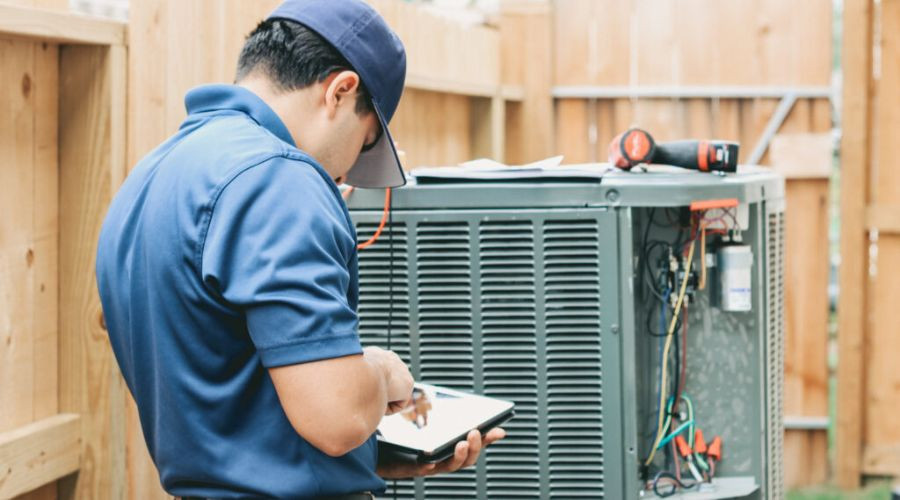HVAC maintenance should be scheduled regularly to make sure that your heating and cooling system is safe and efficient. Preventive maintenance helps extend the life of your system by identifying and addressing issues before they escalate. Here is what to expect during HVAC maintenance services:
Table of Contents
System Inspection
A key component of HVAC maintenance services is a comprehensive inspection. Technicians remove the unit’s panels to review the electrical and mechanical components. Inspections look for signs of wear and tear on key components to provide a clear understanding of the system’s functioning before recommending repairs. Some key parts that are examined include:
- Wiring: Wiring is examined to determine if it is loose or frayed, and connections are tightened to support a safe flow of current. Technicians use ammeters and multimeters to test relays, switches, and contactors to verify they are functioning properly.
- Motors: Motors are checked for wear, and belts are examined for cracks and signs of stretching.
- Thermostat: Technicians test the thermostat by switching the system on and off to make sure it responds correctly.
- Condenser unit: The outdoor condenser unit is inspected for damage to the fins, coils, and fan assembly.
Component Cleaning
Some system components must be replaced over time, while others benefit from cleaning. HVAC experts clean or replace air filters and spray a cleaning solution on the evaporator coils to eliminate dust. They detach the fan from the condenser unit to clear debris from the cabinet. Coil fins are straightened to restore proper airflow. Technicians clean the blower assembly by removing dust from the wheel and housing. Drain pans are flushed, and condensate lines are cleaned to prevent blockages that may cause water damage. By thoroughly cleaning every component, the system circulates air more easily, which reduces strain on the motors.
Performance Testing
Reviewing an HVAC system’s performance can indicate whether parts or the entire system require replacement. Experts check voltage and current at key points to verify the electrical draw is within system specifications. Airflow is measured at supply and return registers to determine if the system is drawing in and blowing out air at a consistent rate. Thermometers are used to compare the air temperature entering and leaving the system, verifying that the equipment is heating or cooling within the desired range.
Technicals also verify that refrigerant levels meet the model’s requirements. When pressures are not within the recommended range, the system may be undercharged or overcharged, which influences efficiency. Safety controls, including high-limit switches and pressure sensors, are tested to make sure that they activate when conditions shift beyond safe limits.
System Adjustments
Making sure thermostats and other components are properly aligned helps support system efficiency. If the system is short-cycling, recalibrating the thermostat may help restore the signal between the thermostat and the blower fan. This improves energy efficiency, as the system should only turn on when your home falls below or above the desired indoor temperature.
Technicians lubricate moving parts, including fan motors and bearings, to minimize friction and wear. Electrical connections found to be resistant during testing are tightened to allow free flow of current. The blower motor speed can be adjusted if airflow measurements show an imbalance. The fan blades are repositioned and fastened to minimize vibration and noise. In systems with belts, professionals adjust tension to maintain a steady operation. These calibrations tune the equipment, enabling all parts to operate at optimal efficiency.
Repair Documentation
An expert documents the results of the inspection, cleaning, testing, and adjustments. These records provide a comprehensive overview of your system’s function and guide recommendations for part replacement. HVAC experts may document refrigerant pressures for comparison at the next visit. Gradual changes are monitored by reading the motor amperage. Through detailed notes, technicians make sure that maintenance is not treated as a one-time service but as a continuous record of system health. These records can also be beneficial later when troubleshooting a malfunction or determining if it is time for a system update.
Schedule HVAC Maintenance Today
HVAC maintenance services encompass thorough inspections, cleaning, and testing to determine which parts need adjustment or replacement to maintain system efficiency. If issues arise, some professionals offer 24-hour emergency services to restore system function with minimal disruption to your home’s comfort. Contact experienced technicians today to schedule a routine inspection to support long-term efficiency.

